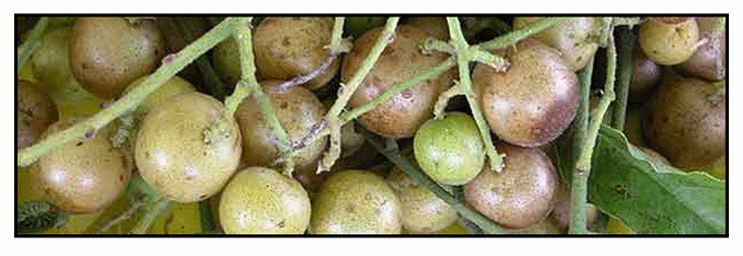 Gen info Gen info
- Clausena is a genus of flowering plants in the citrus family, Rutaceae. It was first defined by Dutch botanist Nicolaas Laurens Burman in 1768. (57)
- Etymology: The genus Clausena was names for the Norwegian clergyman, Peder Clausson Friis (1545-1614), the translator of the Icelandic historian and poet, Snorri Sturluson.
(57)
-
Clausena lansium is a species of strongly scented evergreen trees in the family Rutaceae, native to Southeast Asia.
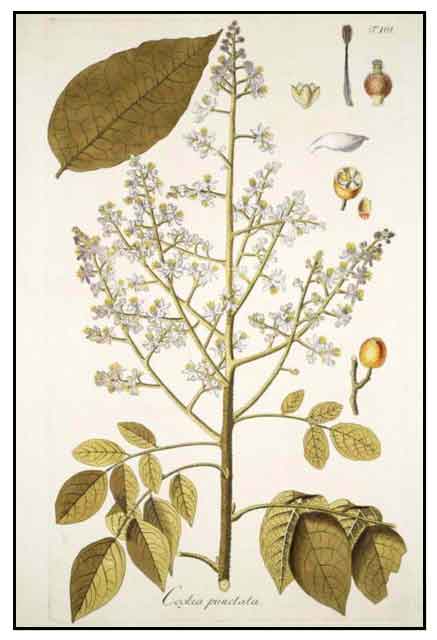 Botany Botany
• Wampi is a small tree about 7 meters high. Leaves are dark green, pinnate, with 5 to 9 leaflets. Each leaflet has a stalk about 3 millimeters long, the blade ovate-elliptic, lanceolate or ovate, about 7 to 10 centimeters or more in length, pointed at the tip, much wider on one side of the base. Flowers are borne in terminal panicles, white, about 14 millimeters in diameter. Petals are five, white, and boat-shaped. Calyx is small and five-parted. Stamens are 10, with conspicuous yellow anthers. Ovary is five-celled, borne on a short stalk, covered with hairy nobs, and surrounded by a short style terminating in a rounded stigma. Fruit is ivory yellow, rounded, about 2 centimeters in diameter, very slightly flattened at the base, somewhat rounded at the tip, and borne in bunches. Skin of the fruit is thin and soft, dotted with minute, raised, somewhat darker-colored spots, covered with short hairs, and marked by five, usually very inconspicuous, longitudinal lines which are lighter in color than the remainder of the fruit. Flesh is yellowish white, soft, juicy, somewhat acid in taste; cross-section shows a division into five segments by thin, white lines. Usually one to four of the segments contain a single, rather large, flattened green seed, attached near the apex of the fruit.
• Tree grows up to 6 m tall, evergreen. Branches long, upward-slanting, flexible. Trunk: Gray-brown bark, rough. Foliage: Spirally arranged; leaves 4-12 inches long, pinnate; leaflets 7-15 alternate, elliptic or elliptic-ovate, 2 3/4 to 4 inches long, oblique at the base, wavy-margined, shallowly toothed; petiole warty and hairy. Flowers: Sweet scent; 4-5 parts, whitish or yellowish-green, 1/2 inch wide, slender, hairy panicles, 4-20 inches long. Fruit: Ovoid or subglobose; thin but tough rind light brownish-yellow, minutely hairy; easily peeled; flesh faintly divided into 5 segments, yellowish-white or colourless, juicy, pleasantly sweet, subacid or sour. Seeds 1-5 oblong, thick, 1/2 - 5/8 inches long, bright-green with one brown tip. (36)
Distribution
- Cultivated, not naturalized.
- Introduced from and commonly cultivated in China for its edible fruit.
- Known in the Philippines earlier than 1837; reintroduced from China in 1912.
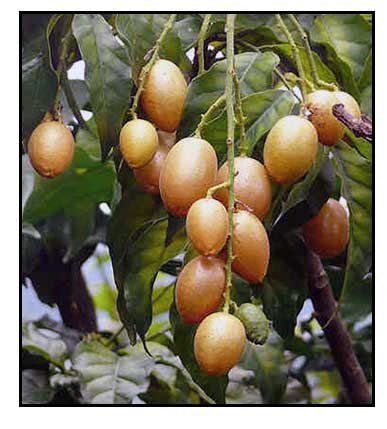 Constituents Constituents
• GC/MS study for essential oil extracted yielded ß-santalol (35.2%),
bisabolol (13.7%), methyl santalol (6.9%), ledol (6.5%), and sinensal (5.6%) from the leaves; Flowers: ß-santalol (50.8%),
9-octadecenamide (17.2%), sinensal (4.1%) from flowers; beta-santalol (52.0%), alpha-santanol (15.5%), farnesol (5.2%), and sinensal (4.0%) from the sarcocarps; and phellandrene (54.8%), limonene (23.6%), p-menth-1-en-4-ol (7.5%). (2)
• Study yielded seven compounds: corchoionoside C, 1'-O-beta-D-glucopyranosyl (2R,3S)-3-hydroxynodakenetin, quercetin-3-O-robinobioside, rutin, quercetin-3-O-scillabioside, kaempferol-3-O-alpha-L-rhamnopyranosyl(1-->2)[alpha-L-rhamnopyranosyl(1-->6)]-beta-D-glucopyranoside and mauritianin.
• Study isolated a novel oxirane carboxamide from a hexane extract.
• Study of fresh and dried fruits of Clausena lansium showed an abundance of amino acids, the total free and hydrolyzed amino was 4.8 mg/g and 15.0 mg/g in fresh fruit; 4.6 mg/g and 15.0 mg/g in dried fruit. (10)
- Study of crude extracts of twigs and roots yielded 12 compounds viz., xanthotoxol (1), imperatorin (2), heraclenol (3), heraclenin (4), wampetin (5), indicolactonediol (6), murrayanine (7), O-demethylmurrayanine (8), indizoline (9), 3-formyl-6-methoxycarbazole (10), lansine (11) and glycozolidal (12). (see study below) (12)
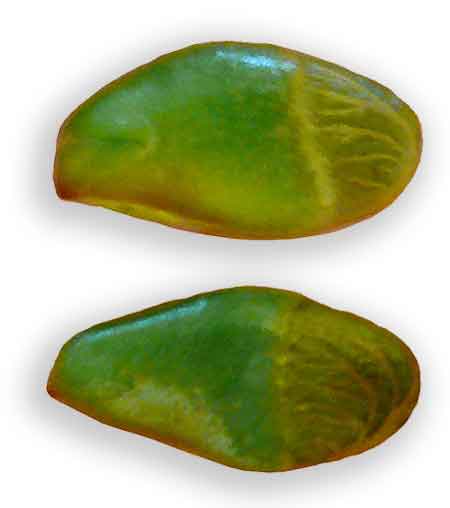 Study isolated six compounds from stems of Clausena lansium viz., imperatorin (1), isoimperatorin (2), 8-geranyloxypsolaren (3), 3-formylcarbazole (4), methyl carbazole-3-carboxylate, (5) and 2-methoxy-1-(3-methyl-buten-1-yl)-9H-carbazole-3-carbaldehyde (6). (see study below) (13) Study isolated six compounds from stems of Clausena lansium viz., imperatorin (1), isoimperatorin (2), 8-geranyloxypsolaren (3), 3-formylcarbazole (4), methyl carbazole-3-carboxylate, (5) and 2-methoxy-1-(3-methyl-buten-1-yl)-9H-carbazole-3-carbaldehyde (6). (see study below) (13)
- Study obtained volatile components from fruits, seeds, and leaves of C. lansium. The sesquiterpene fraction (28%) was the major leaf component, monoterpene (76-98%) in the flesh, skin, and seed. Sabinene was the main component in the leaf (14.9%), flesh (50.6%), skin (69.1%) and seed (83.6%). Other components were: (leaf) ß-bisabolene (9.9%), ß-caryophyllene (7.7%) and α-zingiberene (6.5%); (flesh) 3-cyclohexen-1-ol (15%), cyclohexene (6.5%), 1,4 cyclohexadiene (6.2%) and α-phellandrere (5%); (skin) α-phellandrene (10.6%), α-pinene (9.4%) and isosativene (1.4%); and (seed) α-pinene (4.3%), α-phellandrene (3.0%), and myrcene (2.9%). (14)
- n-Hexane extract of leaves yielded five compounds: dihydroindicolactone (1), 8-geranyloxy psoralen (2), imperatorin (3), heraclenol (4) and indicolactone (5). (see study below) (15)
- Study isolated a novel oxirane carboxamide, SB-204900, from a hexane extract of C. lansium.
(17)
 - 100 g of wampee yields 55 Kcal, 84% moisture, 0.9 g protein, 0.1 g fat, 14.1 g carbohydrate, 0.8 g fiber, 0.9 g ash, 19 mg phosphorus, 281 mg potassium, 15 mg calcium. - 100 g of wampee yields 55 Kcal, 84% moisture, 0.9 g protein, 0.1 g fat, 14.1 g carbohydrate, 0.8 g fiber, 0.9 g ash, 19 mg phosphorus, 281 mg potassium, 15 mg calcium.
- Study of water extract of stems yielded two new phenolic glycosides, Clausenolside A-B (1,2), one new pair of phenolic enantiomers (3a, 3b), two new monoterpenoids, clausenapene A-B (4,5), along with 12 known analogues (6-17). Compounds 1-17 were isolated from C. lansium for the first time. (see study below) (22)
- Study of leaves yielded eight new clausenamides, including three γ-lactams (1–3), four δ-lactams (4–7), an amide (8), along with seven known lactams. (see study below) (29)
- Chemical and spectroscopic study
of plant branches yielded three new furanocoumarins, lansiumarin A, B, and C. (30)
-
GC-MS study of wampee fruits for volatile compounds using four different drying methods yielded 53 components, including 17 monoterpene hyydrocarbons, 14 sesquiterpene hydrocarbons, 10 alcohols, 3 aldehydes, 4 ketones, 1 carboxylic acid, and 4 terpene oxides. Relative peak areas of major components were sabinene (33.68-66.73%), α-pinene (9.57-13.35%), l-phellandrene (5.77-10.76%), and myrcene (3.20-4.50%). (31)
-
Study of roots and rhizomes isolated two new cyclic nonapeptides, clausenlanins A and B. (33)
- Study of water-soluble stem and leaf extract identified 12 compounds, including five aromatic glycosides, four sesquiterpene glycosides, two dihydrofuranocoumarin glycosides, and one adenosine: Claulanaroside (1), Icariside F2 (2), Icariside D1 (3), Vanilloloside (4), Methyl benzoate 2-(6-O-α-l-rhanmopyranosyl)-O-β-d-glucopyranoside (5), claulancoumside (6), 1′-O-β-d-Glucopyranosyl (2S,3R)-3-hydroxyarmesin (7), clausesquiside A (8), clausesquiside B (9), (6R,9R,4Z,7E)-9,10-Dihydroxy-4,7-megastigmadien-3-one-9-O-β-d-glucopyranoside (10), (6R,9S)-roseoside (11), adenosine (12). (see study below) (37)
- Chemical investigation of fruits yielded 16 carbazole alkaloids (1-16), including six new carbazole alkaloids, clausenalansines A-F (1-6). (see study below) (43)
- Study of aerial parts isolated 14 alkaloids, including two indole alkaloids (1 and 2), one quinoline alkaloid (3), two pyridine alkaloids (4 and 5), four carbazole alkaloids (6-9) and five amides alkaloids (10-14). (see study below) (46)
- Study of stems and leaves isolated two new geranylated carbazole alkaloids, clauselansiumines A and B (1 and 2), along with 10 known geranylated carbazole alkaloids (3-12). (see study below) (48)
- Study of fruit isolated three jasmonoid glucosides, 12-β-D-glucopyranosyloxy-6-epi-7-isocucurbic acid-1,6-lactone (1), 12-β-D-glucopyranosyloxyjasmonic acid (2) and 12-hydroxyjasmonic acid (3), two sesquiterpenes, (+)-curcumen-12-oic acid (4) and (+)-(E)-α-santalen-12-oic acid (5), two coumarins, xanthotoxol (6) and indicolactone (7), in addition to 3,4-dihydroxybenzoic acid (8), 5-hydroxymethyl-furaldehyde (9), isopropyl β-D-glucopyranoside (10) and stigmasterol (11). (49)
- Study of 95% ethanol aqueous extract of roots isolated six previously undescribed alkaloids (1a,2a, 2b, 15, 24a, 24b), a pair of prenylated phenylpropenols (26a, 26b), two coumarins (27,28), and two undescribed sesquiterpenes (37,38). (see study below) (52)
Properties
• Bitter, pungent-tasting, slightly
warming, anti-cold, antifebrile, improves circulation and analgesic.
• Considered stomachic, cooling and anthelmintic.
• Studies have shown
antidiabetic, antihyperlipidemic, antioxidant, anti-inflammatory, antitrichomonal, hepatoprotective, antinociceptive, insecticidal, antifungal, antioxidant, nephroprotective, neuroprotective, cognitive enhancing, antimicrobial, anti-Parkinson, tyrosinase inhibitory, cytotoxicity, herbicidal, anti-α-glucosidase, apoptotic, antiproliferative, thrombolytic properties.
Parts
utilized
Leaves, fruits,seeds.
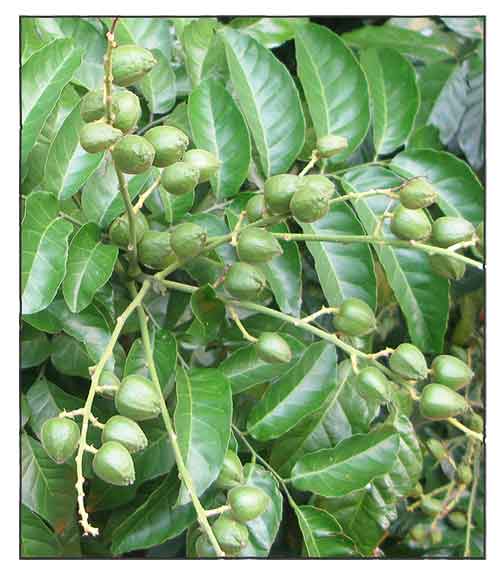 Uses Uses
Edibility
• Fruit is edible, raw, juicy, with a flavor varying from sweet, subacid, and sour.
• Unripe fruits used for making jellies; ripe fruits used for making juice and beverage.
• In China, a much esteemed fruit, made into delicious preserves.
• Skin and seeds often eaten with the pulp, like kumquat.
• Leaves used as condiment in curries; a substitute for Curry leaf tree.
Folkloric
• For influenza, cold, malaria: use 15 to 30 gms dried leaves
in decoction.
• For gastric pains, abdominal colic pains: use drupe, 9-15 gms
in decoction.
• In some countries, used for bronchitis, malaria, hepatitis,
gastrointestinal inflammation.
• In China, used
to treat bronchitis and inflammation. Leaf decoction used as hair shampoo. Used for treatment of abdominal pain, malaria, colds, dermatopathy, and snake bites.
• In Tonkin, the dried fruit is used in bronchitis.
• Leaves have been used for cough, asthma and gastrointestinal diseases; fruit for digestive disorders and seeds for GI disorders and chronic gastrointestinal ulcers.
• Decoction of leaves used as hair wash to remove dandruff and preserve the color of hair. Leaves used for treatment of cough, asthma, hepatitis, and skin diseases.
Others
• Agroforestry: Dense growth provides for a good hedge plant.
Studies
•
Stem Bark / Anti-trichomonal / Anti-diabetic / Anti-inflammatory / Hepatoprotective
/ Antioxidant: Study isolated compounds with various
biologic activities: Imperatorin and 3-formylcarbazole showed anti-trichomonal
activity; Imperatorin and chalepin were the active constituents responsible
for insulin release and anti-diabetic activity. Results also exhibited
antioxidant, anti-inflammatory and hepatoprotective effects. (1)
• Antinociceptive / Neuroleptic:
ß-santalol, the main constituent of the essential oils of leaves,
flowers and sarcocarps has antinociceptive CNS effects and can be considered
a neuroleptic.
• Insecticidal / Seeds:
Phellandrene, the main constituent of the seed oil has been shown to
be insecticidal.
• Hepatoprotective / Leaves:
Study showed the hepatoprotective actions of eight of nine compounds
isolated from the leaves of C lansium, decreasing the hepatotoxicity
of thioacetamide and acetaminophen in mice. (3)
• Antifungal / Antiproliferative
/ HIV Reverse Transcriptase-Inhibition: Study isolated
from the seeds of CL, a homodimeric trypsin inhibitor which exhibited
antifungal, anti-HIV reverse transcriptase and antiproliferative activities. (4)
• Antioxidant / Anticancer: Study of various extracts and fractions showed the ethyl acetate fraction exhibited the highest antioxidant activity, reducing power and superoxide scavenging activity. Also, the EAF exhibited strong anticancer activities against human cancer cell lines – gastric carcinoma, hepatocellular liver carcinoma and lung adenocarcinoma, higher than cisplatin. Results suggest wampee peel as a potential source of natural antioxidants and possible pharmaceutical supplement. (5)
• Antioxidant / Anticancer / 8-Hydroxypsoralen: Study yielded a pure compound - 8-hydroxypsoralen from the wampee peel. It exhibited good scavenging activities against DPPH radical and superoxide anion and also showed potent proliferation inhibition against several human cancer cell lines (hepatocellular liver carcinoma, lung adenocarcinoma and cervical carcinoma). (9)
• Pharmacologic Properties / Biologic Activities: A study showed the superiority of the dichlormethane extract over the methanolic extract. Various activities showed were significant anti-hyperglycemic, hepatoprotective, antioxidant and anti-trichomonal activities. Its antidiabetic action was through stimulation of insulin release, mediated by imperatorin and chalepin.
• Coumarins / Cytotoxicity: Study isolated two new coumarins, clausenalansimin A and B, together with seven known coumarins from the twigs of C lansium. Some isolated showed cytotoxicity against human cancer cell lines (KB, MCF7, and NCI-Hi87).
• Anti-Allergic / Leaves: Study showed extracts contained phenolic, flavones, alkaloid, organic acid, coumarins etc. Results showed the antiallergic components contained mainly phenolics and flavones. The inhibitory effects of aqueous and ethanol extracts on hyaluronidase was about 89 and 75% respectively. (8)
• Bu-7 / Protection Against Rotenone Injury / Parkinson's Disease: Study investigated Bu-7. a flavonoid isolated from the leaves of C. lansium against rotenone-injury in PC12 cells. Results showed Bu-7 protects PC12 cells against rotenone injury, which may be attributed to MAP kinases cascade signaling pathway. Bu-7 may be a potential bioactive compound for the treatment of Parkinson's disease. (11)
• Antibacterial / Anti-Inflammatory: Study of crude extracts of twigs and roots yielded 12 compounds. Pure compounds were evaluated for antibacterial and anti-inflammatory activities. Three carbazole alkaloid components (compounds 10, 11, and 12) demonstrated antibacterial activity against periodontopathic bacteria, Porphyromonas gingivalis. Compound 10 and crude extract of twig exhibited impressive anti-inflammatory potency. (see constituents above) (12)
• Cytotoxic Constituents / Stems: Study of stems yielded 6 compounds. Compounds 4-6 showed potent cytotoxic activity against H1299 (non-small cell lung carcinoma) and SMMC-7721 (liver cancer) with IC50 values of 6.19 to 26.84 µg/mL. (see constituents above) (13)
• Antifungal / Constituents / Leaves: Study of n-hexane fraction of leaves isolated five compounds. In evaluation for antifungal activity against yeast Malassezia globosa, n-hexane fraction showed moderate activity. (see constituents above) (15)
• Hepatoprotective / Leaves: Study isolated nine compounds from the leaves of C. lansium. All nine compounds, except for demethylsecoclausenamide, significantly depressed elevated transaminase in mice intoxicated with CCl4. More abundant components, seco-clausenamide and clausenamide, caused decrease hepatotoxicity of thioacetamide and acetaminophen in mice. Clausenamide significantly inhibited CCl4-induced lipid peroxidation of liver microsomes and C-CCl4 covalent binding to microsomal lipids. (16)
• Wine / Fruit / Brewing Technology: Study reports on the brewing technology of Clausena lansium fruit wine with wine yeast and da qu. Fruit wine produced was dark yellow in color, liquor tasting, sweet, with a fragrant fruit smell, with an alcohol content between 6-9%, sugars <3g/L, and a total acid (citric) 6.0-8.0 g/L. (18)
• Monoterpenoid Coumarins / Hypoglycemic / α-Glucosidase Inhibitory: Study isolated two new monoterpenoid coumarins, clauslactone V (1) and clauslactone W (2), together with known analogues (3-5) from the peels of C. lansium. All compounds (were evaluated for hypoglycemic activity, and compounds 1-5 showed in vitro α-glucosidase inhibitory activity. (19)
• Neuroprotective / Hepatoprotective /
Stems: Water extract of stems isolated 17 compounds. Compounds 3a, 3b, 4, 16, and 17 showed moderate or strong neuroprotective effects on inhibited PC12 cell injury induced by okadaic acid, and compound 9 showed strong potential hepatoprotective activities. (see constituents above) (22)
• Effect of Leaf Stage Development on Phenolic Content and Antioxidant Activity: Wampee leaves are an excellent source of bioactive compounds with high antioxidant activities. Study showed a spectacular increase in bound phenolics, flavonoids, and cellular antioxidant activities with the development of leaves at different stages. Predominantly, quercetin and ferulic acid contents were high in free bound and bound fraction of old leaves. Phenolic components showed highly significant positive association (p<0.05) with antioxidant activity. Old leaves have the same utility value as leaf buds and could be a sustainable source of bioactive compounds for nutraceutical and pharmaceutical industrial applications. (23)
• Antimicrobial Against Periodontopathic Bacteria and Cytotoxic Activity: Study investigated the antimicrobial activity of Cratoxylum formosum ssp. pruniflorum and Clausena lansium against periodontophathic bacteria. The plant extracts showed comparable antimicrobial efficacy against black-pigmented bacteria strains comparable to standard drug chlorhexidine. CD50 of CF and CL on HGF cells were 0.37 and 0.16 mg/ml, respectively. (24)
• Leaf Composition / Antifungal Activity: Stud of n-hexane extract led to the isolated of five compounds i.e., dihydroindicolactone (1), 8- geranyloxy psoralen (2), imperatorin (3), heraclenol (4) and indicolactone (5). Antifungal assay was carried out using Malasseia globosa. The isolated compounds and some fractions showed weak activity against the yeast, except for n-hexane extract which showed moderate activity. Xanthotoxol11 and xanthotoxin12 showed strong activity against the yeast. (25)
• Carbazole Alkaloids / Cytotoxicity to Cancer Cells / Branches and Leaves: Study of a methanol extract of branches and leaves of C. lansium yielded nine carbazole alkaloids (1-9), including two new carbazole alkaloids, claulaniums A and B (1, 2). The compounds were tested for cytotoxic activity against A549 and Hela cancer cell lines. Compounds 2-6 showed varying degrees of cytotoxicity to the cancer cell lines, with IC50s range from 8.67 to 98.89 µmol/L. (26)
• Essential Oil / Tumor Inhibition / Antioxidant / Fruit: Water vapor distillation extracted volatile oil in Wampee fruits. TLC and GCMS revealed 25 peaks and 23 components with high levels of phellandrene (36.97%), terpinen-4-ol (17.58%), sabinene hydrate (13.76%). The concentration of volatile oil in certain concentration rage was positively correlated with the clearance of hydroxyl radical. The EO also showed antibacterial effect to S. aureus, B. subtilis, and E. coli. The EO also exhibited a tumor inhibition effect on mouse pancreatic cancer cells. (27)
• Alkaloids / Lansiumamide / Increase Insulin sensitivity / Anti-Obesity / Seeds: Study of seeds isolated a novel alkaloid, clausoxamine (1), along with six known analogues. Lansiumamide B, was found to reduce fat mass gain and improve insulin sensitivity on high fat diet treated mice. Results suggested a potential anti-obesity and insulin sensitizing agent. (28)
• Clausenamides / Protection of Cortical Neurons / Leaves: Study of leaves yielded eight new clausenamides, including three γ-lactams (1–3), four δ-lactams (4–7), an amide (8), along with seven known lactams. Compound 2 (50 µM) protected 22.24% of cortical neurons against Aß25-35-induced cell death. (29)
• Furanocoumarins / Neuroprotective: Study of stems for bioactive constituents yielded four furano-coumarins, claucoumarins A-D, ad 13 known analogs. On in vitro testing, several of the compounds showed selective neuroprotective effects at concentration of 10 µM. (30)
• Antidiabetic / Lipid Lowering / Leaves: Study of leaves for polyphenolic compounds (PEL) yielded mainly gallic acid, chlorogenic acid, coffee acid, ferulic acid and rutin. The leaves extracts could relieve some symptoms of T2DM in rats, including emaciation, hyperhidrosis, polyphagia, diuresis, liver swelling, kidney and pancreas hypertrophy, as well as reduce fasting glucose. The supplementation of PEL significantly ameliorated lipid related disorders, fat accumulation, and lipid distribution. Results suggest oral use of PEL has potential effects against hyperglycemia and hyperlipidemia in diabetic disorders. (32)
• Clausenamide / Antioxidative / Antiapoptotic / Acetaminophen Induced Nephrotoxicity / Leaves: Study of leaves isolated (+)-clausenamide ((+)--CLA), which was evaluated for protective potential against acetaminophen (APAP)-induced nephrotoxicity in mice. APAP-induced kidney injury significantly increased cell apoptosis in renal tubules. Increase in renal MDA level, depletion of GSH, reductions in CAT and SOD activities in renal tissue suggested APAP-induced kidney injury was mediated by oxidative stress. Results showed the (+)-CLA could be a promising antidote for APAP-induced acute renal damaged through its antioxidant and antiapoptotic effects. (34)
• Anti-Inflammatory / Inhibition of Elastase Release / Roots: Study of roots isolated eight new carbazole alkaloids, claulamines C (1), D (2), and E (5), and clausenalines B-F (3,4,6-8), four new coumarins, clausemarins A-D (9-12), and 43 known compounds. Compounds 9, 13-18, and 20-22 exhibited strong inhibition of superoxide anion generation with IC50s ranging from 1.9 to 8.4 µM, while compounds 18, 19, and 21 inhibited elastase release with IC50s range of 2.0 to 6.9 µM. (see constituents above) (38)
• Antifungal Activity / Essential Oil: Study evaluated leaves and pericarp of C. lansium for essential oil and its antifungal effects. GC-MS analysis identified a total of 101 compounds. Clusters showed different antifungal activities against five Candida species i.e., C. albicans, C. tropicalis, C. glabrata, C. krusei, and C. parapsilosis using disc diffusion method. The EOs of pericarp showed noteworthy antifungal activities against all tested Candida strains with zones of inhibition diameters in range of 11.1 - 23.2 mm. EOs of leaves showed relatively low antifungal activities (ZOI range of 6.6 - 22.2mm). Antifungal activity was attributed to higher contents of ß-phellandrene, ß-sesquiphellandrene and ß-bisabolene in EOs of pericarps. Results support the traditional use of the plants. (39)
• Neuroprotective / Cognitive Enhancing / Peels: Oxidative stress is a pivotal factor in the pathogenesis of many neurological disorders, including ischemic stroke. Study evaluated the neuro-protective and cognitive enhancing effects of C. lansium peel crude extract on neuronal damage and memory deficits in male Wistar rats induced by focal cerebral ischemia (permanent right middle cerebral artery occlusion/RtMCAO). The peel extract showed strong antioxidant activity in scavenging free radicals. In-vivo, only the dose of 4-- mg/kg showed significantly attenuated brain infarction and oxidation indices, restored memory, and antioxidant enzyme activity, and improved densities of survival neurons and cholinergic neurons in the hippocampal region. Results suggest the peel extract may be a useful adjunct for treatment of ischemic stroke. (40)
• Antihyperlipidemic, Hypoglycemic, Antioxidant / Peels: Study evaluated the antihyperlipidemic, hypoglycemic, and antioxidant effects of WP peel extract in experimental T2DM rat model induced by high-fat diet and streptozotocin injection. The HFD/STZ-induced rats exhibited hyperglycemia, dyslipidemia, increased HbA1c, increased lipid peroxidation, and reduced serum antioxidant enzyme activities. The changes were attenuated with highest dose of peel extract. Results suggest potential for use of peel extract in development of novel agents for management of T2DM. (41)
• In-Vitro Effect of Volatile Oil Emulsion on S. aureus / Leaves: Study evaluated the suitable dosage forms of leaf volatile oil and its antibacterial mechanism in vitro. The volatile oil of leaves contained 37 compounds, of which 96.49% were aromatic hydrocarbons, terpenoids, and their oxygen-containing derivatives. The volatile oil showed significant inhibitory effect on S. aureus and altered its cell membrane permeability. It also alleviated inflammation by inhibiting the NF-kB-NLRP3 pathway in S. aureus-infected LLC (S. aureus-infected Lewis lung carcinoma cell model) cells. (42)
• Carbazole Alkaloids / Neuroprotective / Fruits: Study evaluated evaluated the health-promoting constituents of fruits of C. lansium. Chemical investigation yielded 16 carbazole alkaloids (1-16), including six new carbazole alkaloids, clausenalansines A-F (1-6). The alkaloids were tested invitro for neuroprotective effects against 6-hydroxydopamine induced cell death in human neuroblastoma SH-SY5Y cells. Carbazole alkaloids 1-16 displayed remarkable neuroprotective effects with EC50s ranging from 0.36 to 10.69 µM. Results suggest regular consumption of fruits may help prevent occurrence of Parkinson's disease. The neuroprotective effects of the carbazole alkaloids from the fruits could provide for discovery of new agents for the prevention and treatment of Parkinson's disease. (43)
• Tyrosinase Inhibitory / Proanthocyanidins / Fruit Pericarp: The fruit pericarp of C. lansium, a food waste, was used as material for proanthocyanidins analysis using MALDI-TOFMS, HPLC-ESI-MC, and NMR. Results showed the compounds were composed of prodelphinidine (75%) and procyanidin (25%). The compounds proved to be remarkable, reversible, and mixed competitive inhibitors of tyrosinase, with IC50s calculated at 23.6 and 7.0 µg/mL for monophenolase and diphenolase activities, respectively. The proanthocyanidins showed good inhibitory effect on cell proliferation, cellular tyrosinase activity and melanin production of B16 mouse melanoma cells. Results suggest potential application in the pharmaceutical, insecticide, and preservative fields. (44)
• Analgesic / Potential COX Inhibitors: Study evaluated active compounds of C. lansium for analgesic activity by molecular docking study for potential against COX-1 and COX-2. Docking studies have shown that Murrayanine and Clausenaline E had lowest docking score respectively against COX1 and COX2 at -6.471 and -8.325, significant docking scores that suggested potent analgesic activity. (45)
• Antitumor Activity of Alkaloids / Weak Cytotoxicity/ Aerial Parts: Study of aerial parts isolated 14 alkaloids, including two indole alkaloids (1 and 2), one quinoline alkaloid (3), two pyridine alkaloids (4 and 5), four carbazole alkaloids (6-9) and five amides alkaloids (10-14). All the alkaloids were tested against Hela cancer line. Carbazole alkaloids 6-9 exhibited weak cytotoxicity against HeLa cancer cell line with IC50s ranging from 69.31 to 138.32 µM. (46)
• Herbicidal Against Echinochlora crus-galli / Stems and Leaves: Echinochloa crus-galli is a kind of wild grass, considered one of the world's worst weeds, reducing crop yields and forage crops. Study evaluated the herbicidal effect of ethyl acetate (EtOAc) extract from stems and leaves. The EtOAc extract inhibited the growth of roots and shoots of E. crus-galli, the root extracts showing stronger inhibitory effect than shoots. Fifteen compounds were isolated from stems and leaves, including 9 O-mono-terpenoid furanocoumarins and 6 cinnamamides. Among them, compounds 3, 8, and 13-15 showed best inhibitory activities on growth of E. crus-galli roots, with inhibition rates ranging from 70 to 83% at concentration of 300 mg/L. (47)
• Neuroprotective / Geranylated Carbazole Alkaloids / Anti-Parkinson's Potential / Stems and Leaves: Study of stems and leaves isolated two new geranylated carbazole alkaloids, clauselansiumines A and B (1 and 2), along with 10 known geranylated carbazole alkaloids (3-12). The alkaloids were tested for neuroprotective effects against 6-hydroxydopamine induced cell death in human neuroblastoma SH-Sy5Y cells in-vitro. Compounds 1-12 exhibited remarkable neuroprotective effects with EC50s ranging from 0.48 t0 12.36 µM. Results suggest potential as source of new agents for treatment and prevention of Parkinson's disease. (48)
• Antioxidant / Antibacterial / Fruit: Study of fruit isolated three jasmonoid glucosides, 12-β-D-glucopyranosyloxy-6-epi-7-isocucurbic acid-1,6-lactone (1), 12-β-D-glucopyranosyloxyjasmonic acid (2) and 12-hydroxyjasmonic acid (3), two sesquiterpenes, (+)-curcumen-12-oic acid (4) and (+)-(E)-α-santalen-12-oic acid (5), two coumarins, xanthotoxol (6) and indicolactone (7), in addition to 3,4-dihydroxybenzoic acid (8), 5-hydroxymethylfuraldehyde (9), isopropyl β-D-glucopyranoside (10) and stigmasterol (11). Compounds 1-7 were evaluated for antioxidant and antibacterial activities. Among them, compound 6, xanthotoxol, showed antioxidant activity in FRAP and DPPH radical scavenging assays and antibacterial activity against Staphylococcus aureus and Shigella dysenteriae, while compound 5 was active against Bacillus cereus. (see constituents above) (49)
• Lansiumamide / Inhibition of Histamine and TNF-α: Study isolated four known cinnamamides from the plant: lansiumamide C, lansamide I, lansiumamide B, and SB-204900, and evaluated the pharmacological effects of these compounds on mast cells. Lansamide I, lansiumamide B, and SB-204900 significantly decreased histamine release. Lansiumamide B and SBN-204900-treated cells also reduced protein and/or mRNA levels of TNFα. SB-204900 markedly suppressed the phosphorylation of p38 MAPK. Results suggest lansiumamide B and SB-204900 attenuate mast cell-induced inflammation. (50)
• Anticancer and Genotoxicity Effect on Neuroblastoma (SH-SY5Y) Cells: Neuroblastomas are the commonest solid extracranial malignancy in children. Study reports on the synthesis of zinc oxide based nanoparticles using C. lansium peel aqueous extracts and zinc nitrate. ZnONPs may elevate the ATG4 oxidation and disturb the interaction of Beclin-1 and Bcl-2. ZnONPs treatment generated the ROS in the cells and decreased its stability and viability. NAC prevents ROS in the cultured SH-Sy5Y cells and prevents the cells from apoptosis. Results suggest ZnONOs potentially kills the neuroblastoma cells by producing the intracellular ROS. (51)
• Anti-Inflammatory / Inhibition of Pro-Inflammatory Factors / Roots: Study of 95% ethanol aqueous extract of roots isolated six previously undescribed alkaloids (1a,2a, 2b, 15, 24a, 24b), a pair of prenylated phenylpropenols (26a, 26b), two coumarins (27,28), and two undescribed sesquiterpenes (37,38). In-vitro assay showed alkaloids 7, 10,12, 19 and furanocoumarins 34, 35 displayed inhibitory effects on the production of nitric oxide in LPS-induced BV-2 microglial cells. RT-PCR showed indizoline (7) could inhibit expression of pro-inflammatory factors (IL-1ß, TNFα, and IL-6) in LPS-treated BV-2 cells. (52)
• Antifungal Alkaloids / Botanical Fungicides / Leaves: Bioassay-guided study of leaves isolated sixteen alkaloids, including two new and nine known carbazole alkaloids, one known quinoline alkaloid and four known amides. Compounds 4, 7, 12, and 14 showed strong antifungal activity against Phytophthora capsici with IC50s ranging from 50.67 to 70.82 µg/mL. Compounds 1, 3m 8m 10, 12, and 16 showed different degrees of antifungal activity against Botryosphaeria dothidea with EC50s from 54,18 to 129.83 µg/mL. Among all alkaloids, dictamine (12) showed strongest antifungal activity against P. capsici (EC50 50.67 µg/mL) and B. dothidea (EC50 54.18 µg/mL). (53)
• Antihypertensive / Vasoprotective / Fruits: Oxidative stress plays an important role in the patho-physiology of hypertension. Study evaluated the attenuating effect of Wampee fruit extracts on the progression of high blood pressure, endothelial dysfunction, and preservation of antioxidant status using a nitric oxide synthase (iNOS) inhibitor, N(ZG)-nitro-L-arginine methyl ester (L-NAME) induced hypertension and oxidative stress in rats. Results showed arterial blood pressure, vascular superoxide production, and plasma malondialdehyde level were markedly induced in L-NAME treated rats. Results showed daily administration of high dose of fruit extracts significantly alleviated the deleterious effects by attenuation of high blood pressure, reversed the L-NAME-induced suppression in serum levels of nitric oxide, mitigated endothelial dysfunction, reduced oxidative stress, and restored antioxidant glutathione. Results suggest potential as a novel antihypertensive agent. (54)
• Anti-α-Glucosidase / Antityrosinase / Antiproliferative / Apoptotic / Bark Tannins: Study evaluated the anti-α-glucosidase and antityrosinase activity, antiproliferative and apoptotic properties in B16 mouse melanoma cells of condensed tannins from C. lansium bark (CBCTs). The CBCTs greatly inhibited α-glucosidase and tyrosinase with IC50s of 0.60 and 8.5 µg/mL, respectively. The CBCTs were mixed competitive inhibitors of α-glucosidase and non-competitive inhibitors of tyrosinase. The CBCTs could inhibit proliferation and induce apoptosis in B16 melanoma cells. Results suggest potential for development of antidiabetic and skin diseases agents. (55)
• Thrombolytic: Molecular docking studies evaluated the potential binding affinities of phytocompounds from C. lansium viz., Clausemarin B, Clasenaline C, Clausenaline E, Murrayanine, vanillic acid and Xanthotoxol for thrombolytic activity. Clausemarin B showed the best molecular docking score (-6.926) and is the best compound for thrombolytic activity. (56)
Availability
Cultivated. |


![]()

